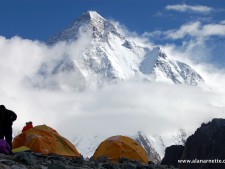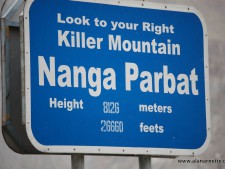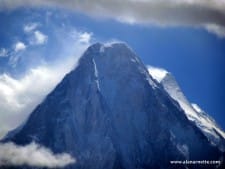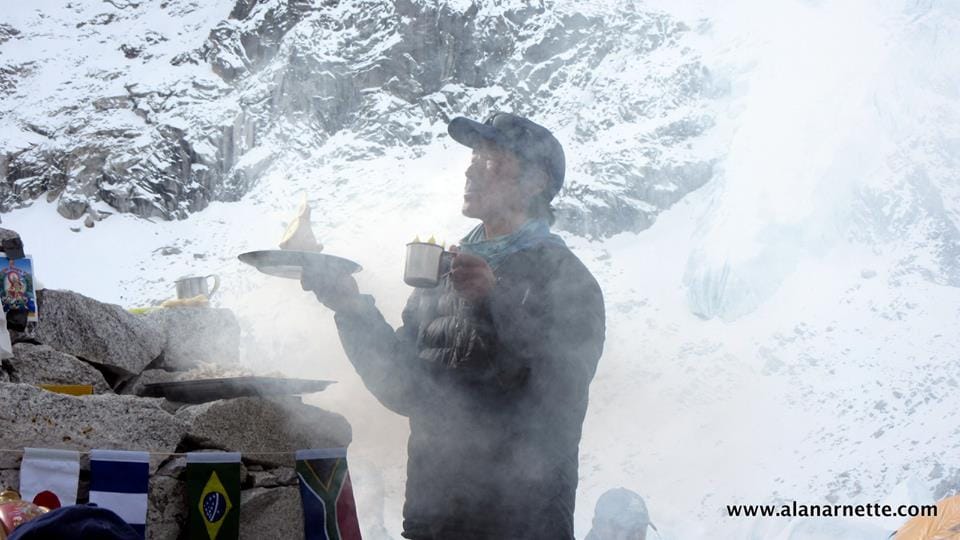After a tragic Everest season, many climbers will continue their quest to summit the world’s highest mountains by moving to Pakistan. The Karakorum Range holds five of the 14 mountains higher than 8000 meters aka the 8s.
Raheel Adan does a great job of covering Pakistan and just published a list of the expeditions on his website
K2, as always, draws the most attention and rightfully so. This year, two companies are leading commercial teams there which might be considered a milestone in mountaineering. Of note, I don’t believe K2 will become the “next Everest” for commercial guides as I explain later.
 K2
K2
2014 was a banner year for the “Savage Mountain” with 40 summits, including myself who became the 18th and oldest American to summit K2. It is the world’s second highest at 8611 m, 28,251 feet.
Many have speculated that K2 was about to become the “new Everest” with summits by people like myself 🙂 I addressed this in one of my post K2 blogs but in summary. I don’t think K2 will become Everest due to the low success rate of summits, high death rates and skill required from the climbers.
I said in my post:
With K2 being my 36th major expedition including four on Everest, my honest assessment is that K2 is not Everest. As anyone who has read my blog for the past decade can attest, I have utmost respect for Everest and her climbers. It is the highest mountain in the world after all! But K2 is totally different.
While K2 is lower than Everest by about 800 feet, the climbing presents an entirely different level of difficulty, complexity and needs for skills. Each climber must has proven, long term skills in rock, ice, snow. Falter on one, you gamble with your life.
The fixed ropes are mostly a placebo, some showing the route but others not strong enough to stop a fall.
You actually rock climb using hands and feet, look for hand holds, literally use your upper body to ascend using a jumar. You use the front points of your crampons, not for traction on a snow slope, but to secure your body to a vertical ice or rock wall. It is a game of tiny edges, of inches. Your body is supported by your feet, your hands prevent you from falling backwards. If you slip on loose rocks and are not properly secured, you will fall and die. There is no recovery opportunity. Climb K2 is about as serious as one can get and at severe altitude.
And the decent is in some ways worse. You must rig rappels (or abseil) over and over, each one must be perfect, there is zero room for error. There is a maze of old ropes on K2 that need to be cleaned up. If you choose the wrong rope, and you slip thus weighting the rope, it will break under your weight. You are exhausted, the lack mental focus is very real so mistakes are easy and often. No one can climb for you, you are on your own, totally responsible for yourself; no guide, sherpa, teammates or porter can climb for you. You must be constantly on the outlook for large, as in microwave size, falling rocks that can kill you instantly. Avalanches are a constant threat.
And the weather …
In both 2012 and 2014, the weather made K2 “easier” We had a solid week of low winds and light precipitation that greatly reduced the risks. That said, those on the first summit push on July 26 came extremely close to getting frostbite and stopping their attempt as they waited for the lines to be fixed across the Traverse. Many are lucky they did not loose fingers, toes or worse – this will be underreported in my experience.
One person did die. Spaniard, Miguel Angel Perez Alnarez, died at Camp 4 after two summit pushes. Everyone watched the situation unfold and stayed in radio contact with him but he was climbing solo and at first without supplemental oxygen. Rescue teams were sent to give aid as soon as he called for help but they were too late. It takes at least two days to reach him from base camp, helicopter impossible at 8000m. It is a tragic situation and I want to extend my deep condolences to his family and friends. But this situation highlights how dangerous any 8000m mountain can be in good or bad weather.
This year, 2015, two companies are leading commercial climbs: Madison Mountaineering with 5 members and Himalayan Experience with 12. Both will be supported with a 1:1 ratio of Sherpas to members plus Pakistan High Altitude Porters (HAPs).
Russell Brice hand picked his team based on previous expeditions. One member with a lot of high altitude experience is David Tait, who has summited Everest five times, all with Brice, and completed a traverse from North to South on the Big E.
Vanessa O’brein, who has the female speed record for the Adventure Grand Slam (7 Summits plus North and South Poles) is climbing with Garrett Madison. In addition, Pakistan operators including Nazir Expeditions and Adventure Tours Pakistan will be fielding their own teams usually made up of individuals working together with little on-mountain support. Nepal operator Seven Summits Treks, is also schedule to provide logistics for a disparate team in 2015.
We were lucky with the weather last year in that 3 of the previous 5 years saw no summits due to bad weather. We will see what 2015 holds for these teams. I don’t expect the earthquakes in Nepal to be a factor in the Karakorum this year.
 Broad Peak
Broad Peak
Sitting about a mile way from K2 is Broad Peak, the world’s 12th highest mountain at 8047 m, 26,414 feet.
Many people try to use Broad as an acclimatization climb prior to K2 but few accomplish this double. In 2015, Bulgarian Boyan Petrov did just that. I met him on the way up K2, and was immediately impressed by his energy and drive. I knew he would make it.
It is considered a straight forward climb. The constant, but quite low angled steepness to the summit ridge can hold avalanche danger, but apart from that there are no technical surprises. Some rocky sections are around the false summit and exposure offers the final test before reaching the true summit.
However Broad Peak can be deadly as was shown in 2013 when Maciej Berbeka, Adam Bielecki, Tomasz Kowalski and Artur Ma?ek made the first winter ascent. During the descent Berbeka and Kowalski went missing from the summit. Also in 2013, a group of five Iranian climbers attempted to ascend through a new route from the southwestern face. Three of them Aidin Bozorgi, Pouya Keivan, and Mojtaba Jarahi, ascended successfully but during descent all three of them were lost and declared dead.
Chris Jensen Burke, who summited K2 last year, after a thwarted attempt on Broad Peak is back to try to get Broad this year. If she is successful this will be her ninth 8000m summit. She is climbing on a logistics permit along with Lakpa Sherpa. Al Hancock, who attempted Annapurna this past spring along with Chris and Lakpa will also be on BP.
Looking to finish the 8s, Catalan climber, Oscar Cadiach is on BP. Spanish Basque alpinist Juanito Oiarzabal, will also be on Broad as he attempts to set a record of climbing the 8s twice!
 Nanga Parbat
Nanga Parbat
Only Nanga Parbat and K2 remain without winter summits demonstrating how severe the weather is during the winter months in Northern Pakistan. Multiple expeditions of expert climbers attempted it in the winter of 2014/15 without success.
Nanga has gained an infamous reputation after the 2013 attack by 15 extremist militants wearing Gilgit Scouts uniforms shot to death ten foreign climbers (one Lithuanian, three Ukrainians, two Slovakians, two Chinese, one Chinese-American and one Nepali)and one Pakistani guide at Base Camp. Another foreign victim was injured. The attack occurred at around 1AM and was claimed by a local branch of the Taliban.
There are no announced expeditions on Nanga Parbat for this summer but some teams go in quietly until they are on the mountain to reduce risks.
 Gasherbrum I and II
Gasherbrum I and II
The Gasherbrums hold the honor of being both “achievable” and one of the most difficult 8s.
G1 at 8068 m, 26,444 feet is considered the more difficult climb when the icefall and some easy ground is covered with snow and ice. It has steep mixed climbing and some objective danger along the entire route
GII at 8035 m, 26,358 feet was considered one of the easiest 8000m peaks, usually together with Shishapamgma and Cho Oyu. After the “Banana Ridge’s” collapse the climb has become more difficult. The main obstacles are the huge icefall, crevasses, some steep climbing on snow and the exposure on the final part.
2015 will see see several international climbers working together on a common permit. Nick Rice will be attempting G1 with logistics provided by Manzoor Ahmad of Karakoram Tour Pakistan.
Best of luck to everyone this season
Climb On!
Alan
Memories are Everything








5 thoughts on “K2 summer Climbs and more”
Alan, will you still be attempting Shishapangma and Cho Oyu this autumn?
Alan, thanks for this. Will you be covering any of the teams climbing K2 this year?
Jacqueline, as much as I can but Karakorum teams are notorious for not blogging – they are kind of busy 🙂
Thanks Alan. You were rather busy too on K2 but you kept us all informed with updates during your climb which many of us were grateful for 🙂
Comments are closed.